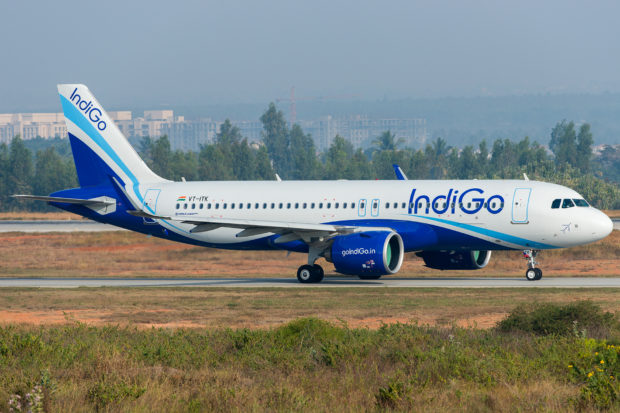India’s aviation regulator, the Directorate General of Civil Aviation (DGCA) has directed both Indigo and GoAir to replace at least one of the Pratt & Whitney PW1100G geared turbo-fan (GTF) engines on the A320neo aircraft within the next fifteen days.
This comes after Indigo reported a series of incidents involving in-flight engine shutdowns (occurred on the 24th, 25th and 26th of October).
The cause of these shutdowns has been traced to problems with the Low-Pressure Turbine (LPT). The DGCA order effectively means that a total of 29 aircraft will have to undergo engine changes. Whether enough spare engines will be available for these replacements remains to be seen.
A new engine architecture, but was it rushed?
The Pratt & Whitney GTF engine is the newest clean-sheet design for an engine in the last three decades. Key to the success of the engine is the efficiency it provides in terms of a lower fuel burn and with a lower noise foot-print.
These two features are achieved by spinning the multiple compressor fan and turbine blades within the engine independently, each at their optimal speeds, with a gear-box in-between.
Read our detailed analysis on the PW1100 GTF engine and its initial issues.
The introduction of the engine saw teething issues. In early 2017, these included:
- Combustion chamber failures, 25% degradation in coastal environments
- Number 3 bearing failures
- Main Gear Box (MGB) failures
2018 saw an additional issue emerge with the knife-edge seal. This led to the European Aviation Safety Agency (EASA) issuing an emergency airworthiness directive (EAD) affecting Airbus A320neo and A321neo powered by the Pratt & Whitney PW1100G geared turbofan (GTF) engines.
EAD 2018-0041-E identified an increased risk of in-flight shut down (IFSD) on all PW1127, PW1130 and PW1133 engines with engine serial number (ESN) P770450 or later. The problem was traced to a knife-edge seal on the high pressure compressor (HPC) aft hub. The issue saw the grounding of several A320neos of Indigo and GoAir.
The year 2019 has seen continued challenges. By Indigo’s own admission there are three issues with PW engines which have been addressed or are in the process of being addressed. These being:
- 3rd stage low pressure turbine issues – addressed via new materials
- Main Gear Box issues – addressed via a software change
- Vibrations – in the process of being explored
Why are the issues continuing?
The GTF engines entered commercial service in 2016, and have logged over four million flight hours of passenger service. Why do these challenges continue? Why were these challenges not identified during testing itself?
In an era where despatch reliability is critical for airlines given the high aircraft utilisation and increasingly stringent laws on delays, how are airlines being compensated? Is this not a net loss to Pratt & Whitney?
The question on everyone’s mind — by when does PW expect the engine to be incident free?
Other GTF engine models being affected?
Pratt’s GTF engine problems have further expanded to beyond the A320 family aircraft. Recently the PW1500G engines that power the new A220 (former Bombardier CS-100 and CS-300) also faced issues. These resulted in forced landings for three aircraft.
The US regulator Federal Aviation Administration is reportedly investigating these incidents and attempting to discern if this was a result of a software flaw or if it is a component defect. The FAA has just issued an airworthiness directive (AD) Docket No. FAA-2019-0843; Product Identifier 2019-NE-27-AD; Amendment 39-19777; AD 2019-21-11 which cover the PW1500G and PW1900G engines which power the new generation smaller jets from Airbus (A220) and Embraer (E195-E2). Effectively the vast majority the new generation regional and smaller narrow-body jets.
It doesn’t reflect well on Pratt & Whitney, an engine manufacturer that has been in existence for over 90 years with over half a million engines delivered during that time.

IndiGo provisioning for GTF engine issues?
The recent Q1 fiscal year 2020 results of Indigo seem to indicate the airline is already provisioning for issues with its GTF engines, by increasing utlisation of its non-GTF powered A320ceo fleet. Our financial analysis of IndiGo’s recent Q1 results provides greater details on the increased provisioning for maintenance.
Is Indigo losing faith in PW?
Luckily for Indigo, these incidents which preceded their earnings announcements were not discussed. Their COO expounded on the fact that their In-flight Shut-down (IFSD) rate was 0.01 per 1000 engine flight hours as compared to the FAA/EASA requirement of 0.05 per 1000 flight hours.
The recent announcements including the large engine order with CFM for LEAP-1A engines for 280 aircraft and the fact that the latest 300 aircraft order with Airbus was announced without the engine order presumably point to the fact that Indigo continues to face challenges with its PW engines.
India’s operating environment far different
The claim conveniently overlooks the fact that operating conditions in India are far different when compared to North America or Europe. India is considered “hot and high”, many of our major cities are on the coast with salt in the air, and without doubt, India is far more dusty. Standards should be more stringent. After the Boeing 737 MAX fiasco, and the skeletons tumbling out of the closet, the Indian aviation industry cannot take FAA certification as a sacrosanct stamp of approval. Should the DGCA and India’s airlines think more independently?
 Bangalore Aviation News, Reviews, Analysis and opinions of Indian Aviation
Bangalore Aviation News, Reviews, Analysis and opinions of Indian Aviation



